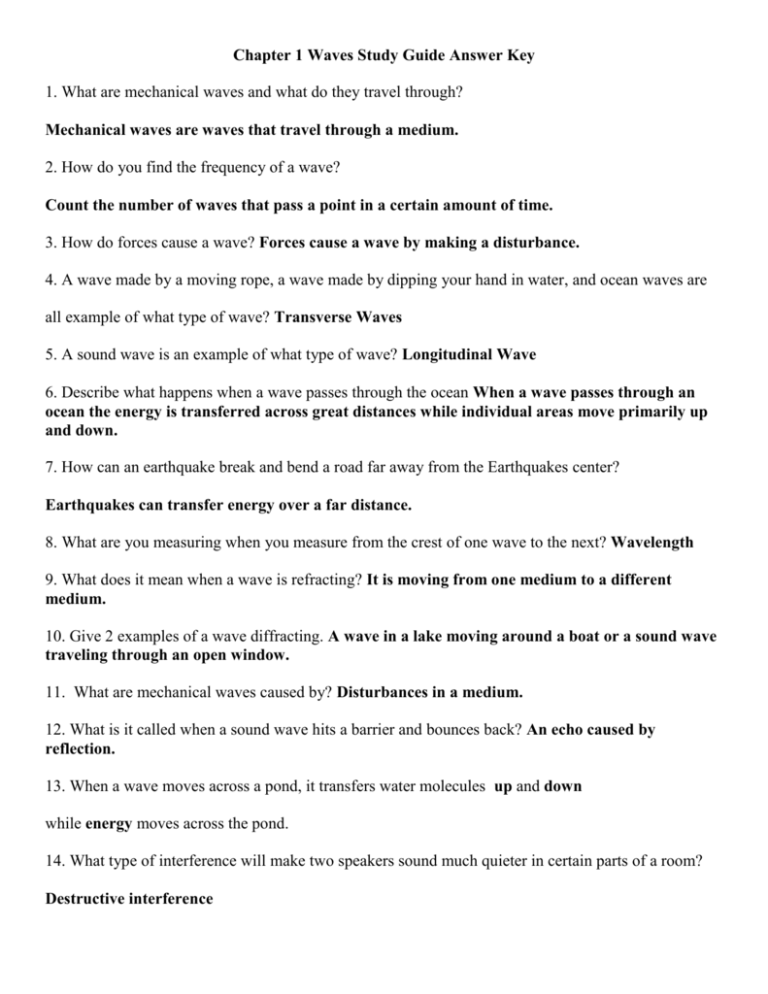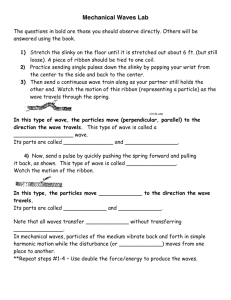Chapter 1 Waves Study Guide w
advertisement

Chapter 1 Waves Study Guide Answer Key 1. What are mechanical waves and what do they travel through? Mechanical waves are waves that travel through a medium. 2. How do you find the frequency of a wave? Count the number of waves that pass a point in a certain amount of time. 3. How do forces cause a wave? Forces cause a wave by making a disturbance. 4. A wave made by a moving rope, a wave made by dipping your hand in water, and ocean waves are all example of what type of wave? Transverse Waves 5. A sound wave is an example of what type of wave? Longitudinal Wave 6. Describe what happens when a wave passes through the ocean When a wave passes through an ocean the energy is transferred across great distances while individual areas move primarily up and down. 7. How can an earthquake break and bend a road far away from the Earthquakes center? Earthquakes can transfer energy over a far distance. 8. What are you measuring when you measure from the crest of one wave to the next? Wavelength 9. What does it mean when a wave is refracting? It is moving from one medium to a different medium. 10. Give 2 examples of a wave diffracting. A wave in a lake moving around a boat or a sound wave traveling through an open window. 11. What are mechanical waves caused by? Disturbances in a medium. 12. What is it called when a sound wave hits a barrier and bounces back? An echo caused by reflection. 13. When a wave moves across a pond, it transfers water molecules up and down while energy moves across the pond. 14. What type of interference will make two speakers sound much quieter in certain parts of a room? Destructive interference 15. When you see your shadow on the ground, you are seeing the light waves do what around you? Diffraction of the light around you 16. When waves pass around a solid barrier what do you predict will happen when the waves reach the barrier? The waves will reflect off the barrier or diffract around the barrier 17. Describe the movement of a transverse wave. The wave moves in a perpendicular direction to the disturbance. 18. What is constructive interference? This is when the crests and troughs of two waves align exactly. 19. What does amplitude measure? The height of a wave compared with the resting point of the wave. 20. A straw in a glass of water appears to be broken or split, what is this caused by? Refraction 21. a. What is the amplitude of the wave? (answer should be in meters) 0.2 meters b. Label the crest and the trough on the graph. c. The graph shows waves moving in a pond. What does the line across the top of the graph show? The wavelength Answer #22-24 on a separate sheet of paper and attach it to your study guide 22. A vacuum is an area with no matter in it, not even air. If you were in a vacuum, you could not hear a sound, even if it were made right next to you. Why is this? Remember to think of the sound as a mechanical wave. A mechanical wave needs a medium to travel through. Otherwise, it cannot transfer energy. In a vacuum, there is no medium for the wave to travel through. Since sound is a mechanical wave, it cannot travel in a vacuum, so you would not hear it. 23. What do you predict will happen when a wave moves from a thinner substance, such as water, into a thicker substance, such as oil? Be sure to use the concepts of speed and refraction in your answer. The speed of the wave depends on the medium through which it passes, so the speed will change when the wave passes from water into oil. I predict that the speed will decrease because it takes more force to move the heavier oil. The wave will probably also refract as it moves from one medium to the other. 24. Choose a type of wave that we made during the wave lab in class. Draw a picture of the wave that was made and describe what type of wave it was and how the wave was made. Show in the picture the direction of disturbance and direction of the wave. Be sure to include how you know whether it is a transverse or a longitudinal wave. (answers will vary here are examples) Transverse wave – was made when we made a crowd wave, a wave with a rope, and one of the waves with the slinky. In a transverse wave the disturbance is in a perpendicular direction to the direction the wave (or energy) travels. Longitudinal wave – this type of wave was made when we used the slinky and when we tapped the side of the aluminum pan. In this type of wave the direction of the disturbance and the direction of the wave are the same.







